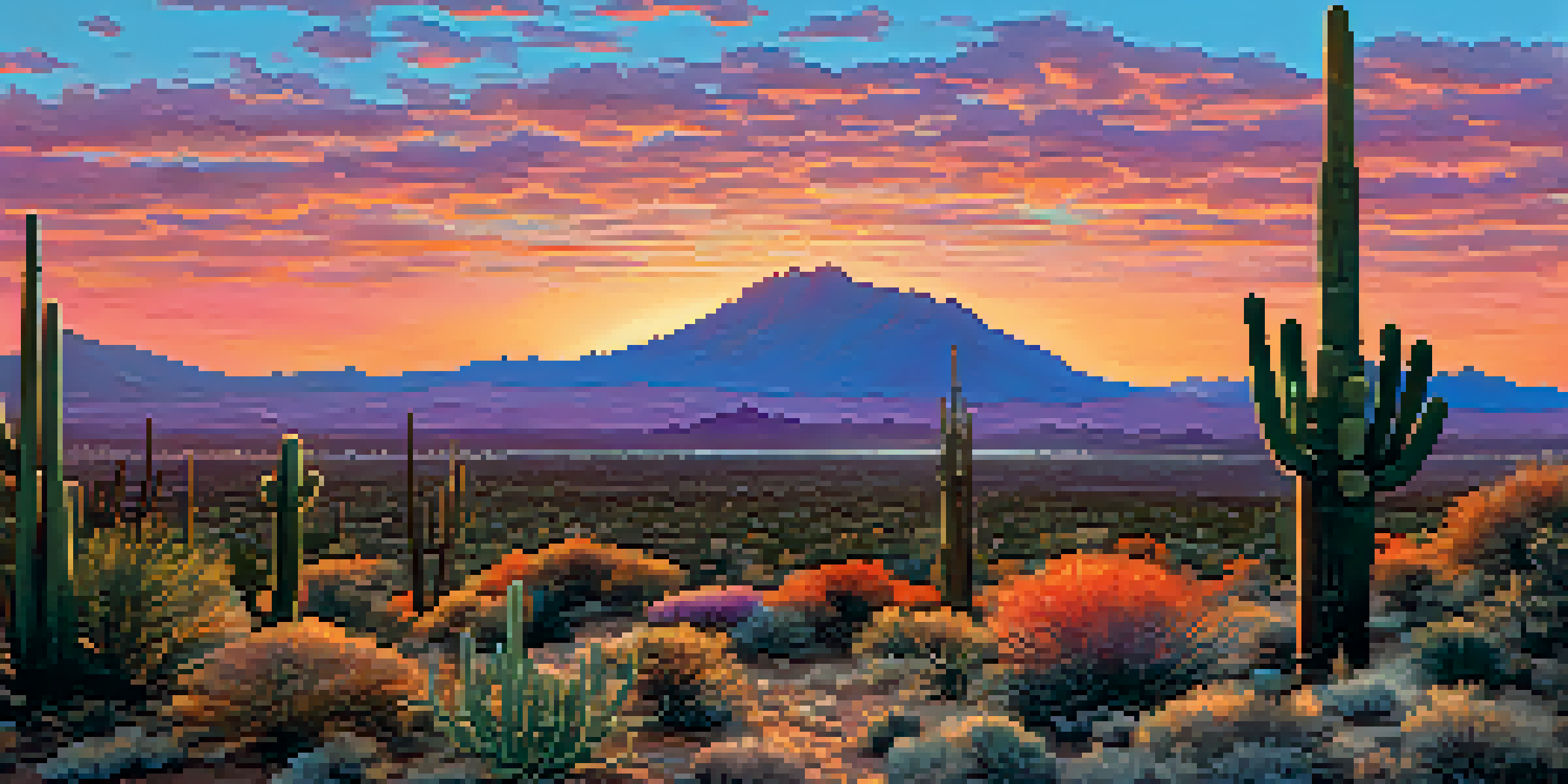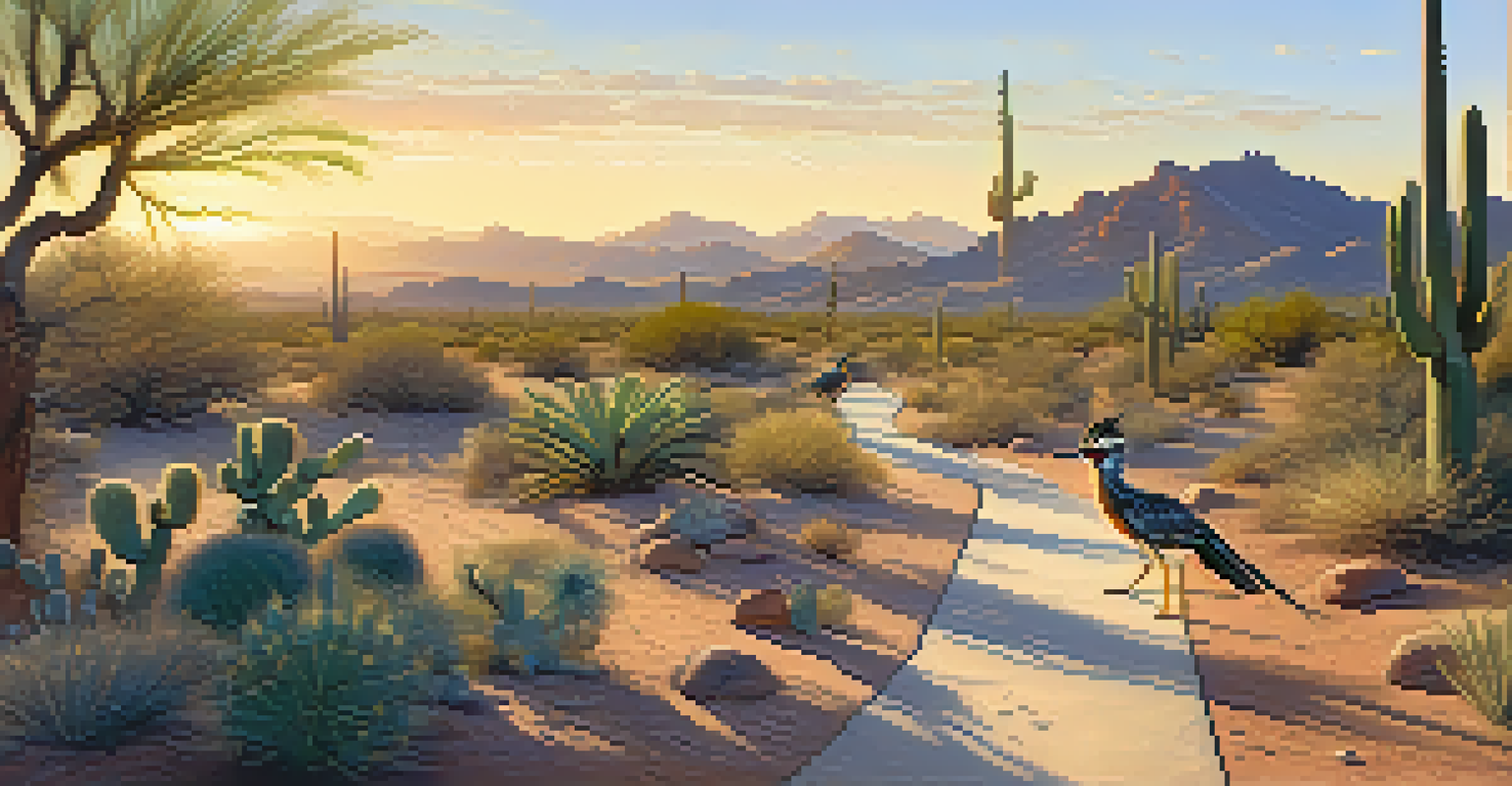Exploring the Sonoran Desert: Wildlife and Conservation Efforts

Introduction to the Sonoran Desert's Unique Ecosystem
The Sonoran Desert, spanning parts of Arizona, California, and Mexico, is a vibrant ecosystem teeming with life. Its unique climate, characterized by extreme temperatures and seasonal rains, creates a habitat that supports a wide variety of flora and fauna. From towering cacti to elusive desert mammals, this region showcases nature's resilience in harsh conditions.
The best time to plant a tree was twenty years ago. The second best time is now.
One of the striking features of the Sonoran Desert is its biodiversity. It is home to over 2,000 plant species and more than 500 animal species, including iconic creatures like the Gila monster and the roadrunner. This incredible variety not only captivates nature lovers but also plays a crucial role in maintaining the ecological balance of the region.
As we delve deeper into the Sonoran Desert, it becomes clear that understanding its wildlife is essential for effective conservation efforts. By appreciating the intricate relationships between species and their environments, we can work towards preserving this remarkable desert for future generations.
Key Wildlife Species of the Sonoran Desert
The Sonoran Desert boasts a plethora of wildlife, each uniquely adapted to thrive in its arid conditions. Among them, the majestic saguaro cactus serves as a vital resource for birds and insects, providing food and shelter. Additionally, the desert tortoise, a threatened species, exemplifies the delicate balance of life in this ecosystem.

Other notable residents include the agile coyote and the elusive bobcat, both of which play essential roles as predators in the food chain. Their presence helps regulate populations of smaller animals, maintaining the ecological equilibrium. Moreover, the desert is rich in reptiles, such as rattlesnakes and lizards, which contribute to the diverse tapestry of life.
Biodiversity of the Sonoran Desert
The Sonoran Desert houses over 2,000 plant and 500 animal species, showcasing its rich biodiversity and ecological significance.
Understanding these species' behaviors and habitats is vital for their conservation. By studying their interactions within the ecosystem, we can create effective strategies to protect them from threats like habitat loss and climate change.
The Role of Cacti in the Desert Ecosystem
Cacti are often seen as the quintessential symbol of the Sonoran Desert, but their role extends far beyond aesthetics. These remarkable plants provide essential resources like water and food for various wildlife, especially during dry spells. The saguaro cactus, in particular, is a keystone species, supporting numerous birds and mammals.
In every walk with nature one receives far more than he seeks.
In addition to their ecological importance, cacti also help stabilize the soil, reducing erosion and promoting healthier ecosystems. Their ability to store water allows them to thrive in extreme conditions, making them a vital resource for both wildlife and humans living in or near the desert.
Conserving cacti and their habitats is crucial, as they are increasingly threatened by urban development and climate change. Protecting these plants ensures the survival of the myriad species that depend on them and helps maintain the overall health of the desert ecosystem.
Conservation Challenges in the Sonoran Desert
Despite its beauty and biodiversity, the Sonoran Desert faces significant conservation challenges. Urbanization, agriculture, and climate change pose threats to the delicate balance of this ecosystem. As cities expand and agricultural practices intensify, habitat loss becomes a pressing issue for many native species.
Water scarcity is another critical challenge, as rising temperatures and changing precipitation patterns affect both wildlife and plant life. Many species struggle to adapt to these rapid changes, leading to declining populations and increased competition for resources.
Conservation Challenges Ahead
Urbanization, climate change, and water scarcity threaten the delicate ecosystem of the Sonoran Desert, necessitating urgent conservation efforts.
Addressing these challenges requires concerted efforts from conservationists, policymakers, and local communities. By promoting sustainable practices and increasing public awareness, we can work together to protect the Sonoran Desert's unique wildlife and habitats.
Community Involvement in Conservation Efforts
Community involvement is a cornerstone of successful conservation initiatives in the Sonoran Desert. Local residents play a critical role in protecting their environment, whether through volunteer programs, educational outreach, or citizen science projects. Engaging the community fosters a sense of stewardship and responsibility towards the desert's natural resources.
Organizations like the Sonoran Desert Conservation Plan encourage local participation by providing resources and opportunities for residents to get involved. Through workshops, guided hikes, and educational programs, community members learn about the unique ecology of their region, empowering them to make informed decisions that benefit their environment.
By fostering a collaborative spirit, we can create a more sustainable future for the Sonoran Desert. When individuals and communities unite for a common cause, the impact can be profound, ensuring that this remarkable ecosystem thrives for generations to come.
Innovative Conservation Strategies in Action
Innovative conservation strategies are helping to protect the Sonoran Desert's unique wildlife and habitats. One approach involves the restoration of native plant species to support local ecosystems and provide food sources for native wildlife. These initiatives not only enhance biodiversity but also combat invasive species that threaten the delicate balance of the desert.
Another effective strategy is the establishment of wildlife corridors, allowing animals to safely traverse urban areas and access necessary resources. These corridors help mitigate the impacts of habitat fragmentation, ensuring that populations remain healthy and genetically diverse.
Community Drives Conservation
Local community engagement in conservation programs is vital for protecting the Sonoran Desert's unique wildlife and habitats.
By embracing cutting-edge technologies, such as remote sensing and citizen science apps, conservationists can monitor wildlife populations and track changes in the environment. These tools enable data-driven decision-making, enhancing the effectiveness of conservation efforts in the Sonoran Desert.
Conclusion: The Future of the Sonoran Desert
The future of the Sonoran Desert hinges on our ability to balance human activity with the needs of its unique wildlife. As we face ongoing challenges like climate change and habitat loss, it is essential to prioritize conservation efforts to protect this irreplaceable ecosystem. By working together, we can ensure that the desert remains a vibrant home for its diverse inhabitants.
Education and awareness play pivotal roles in this endeavor. By sharing knowledge about the desert's wildlife and the importance of conservation, we can inspire others to take action. Whether through volunteering, supporting local initiatives, or simply advocating for sustainable practices, every effort counts.

Ultimately, preserving the Sonoran Desert is not just about protecting wildlife; it's about safeguarding a way of life that connects us to nature. By nurturing this incredible landscape, we can foster a sense of wonder and appreciation for the natural world, ensuring it thrives for generations to come.